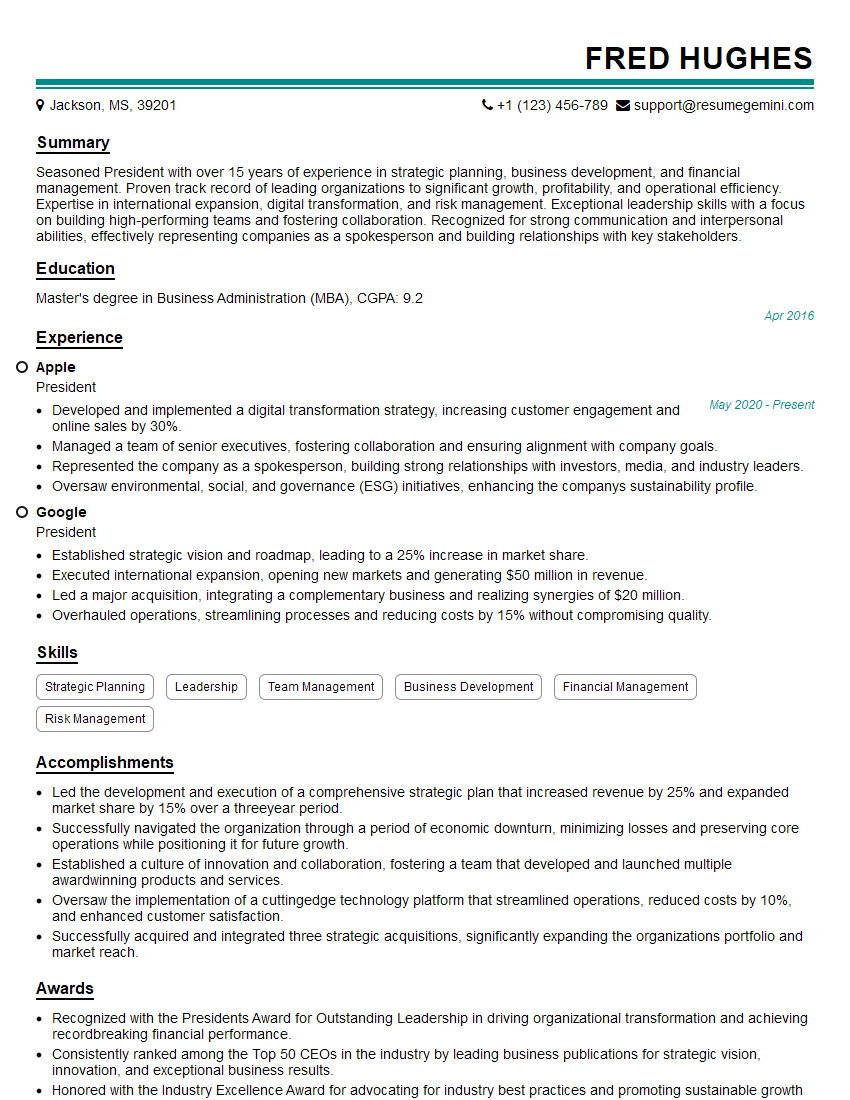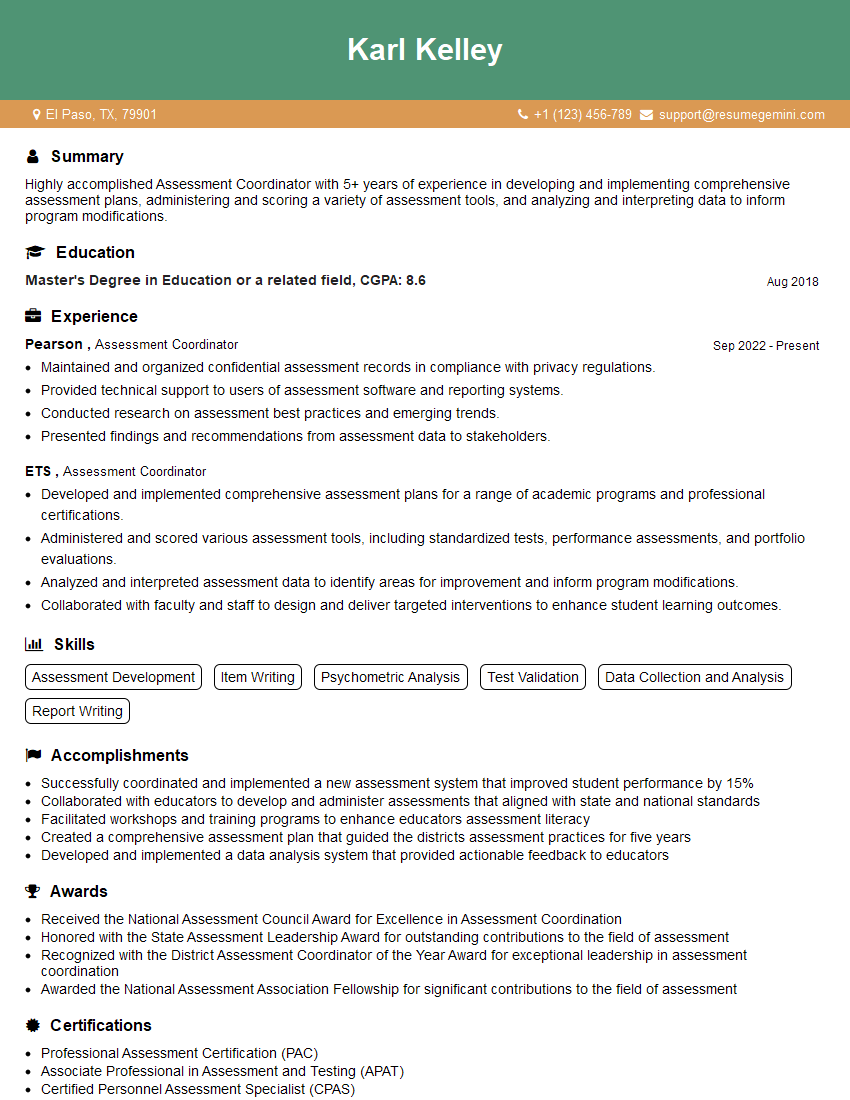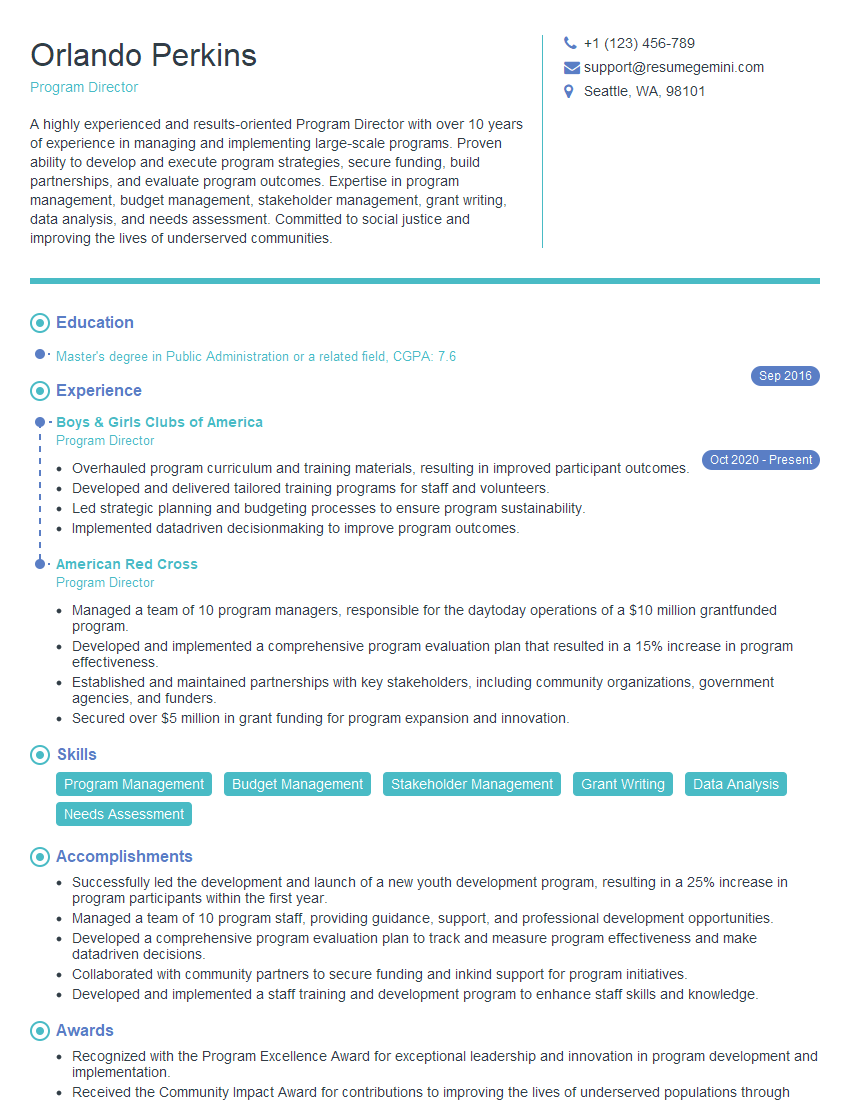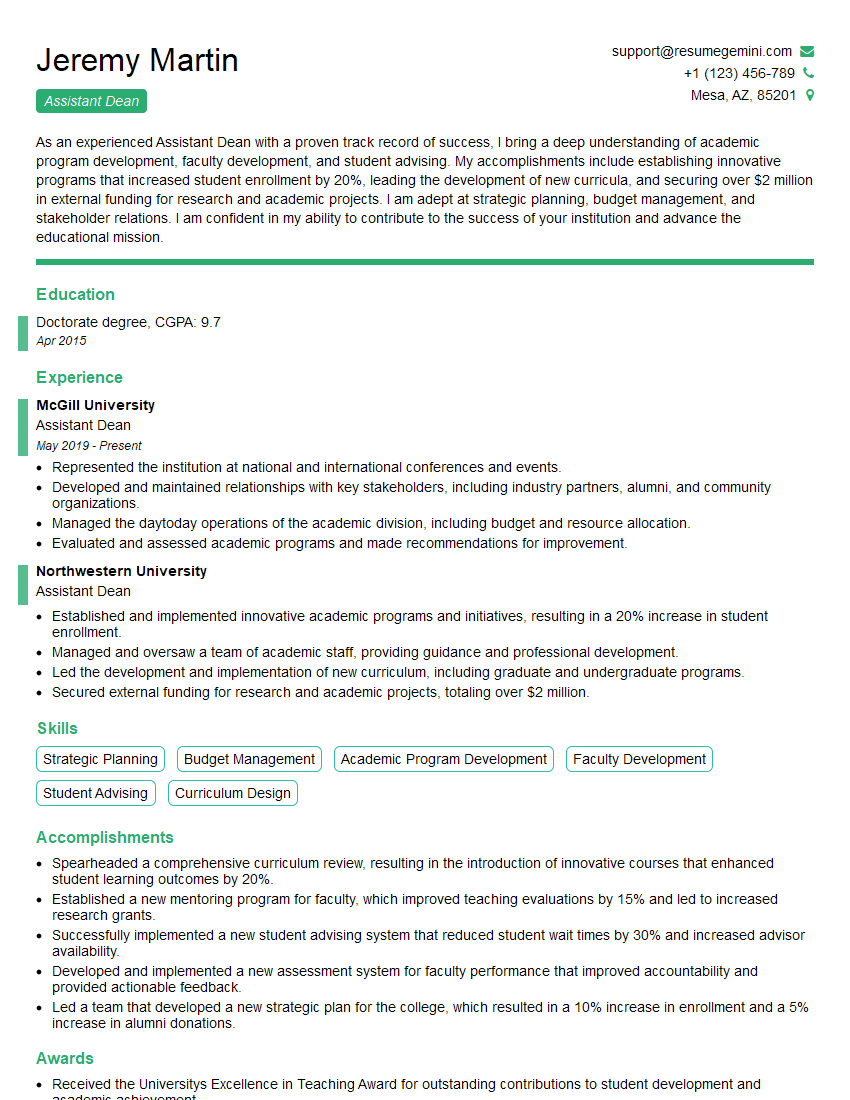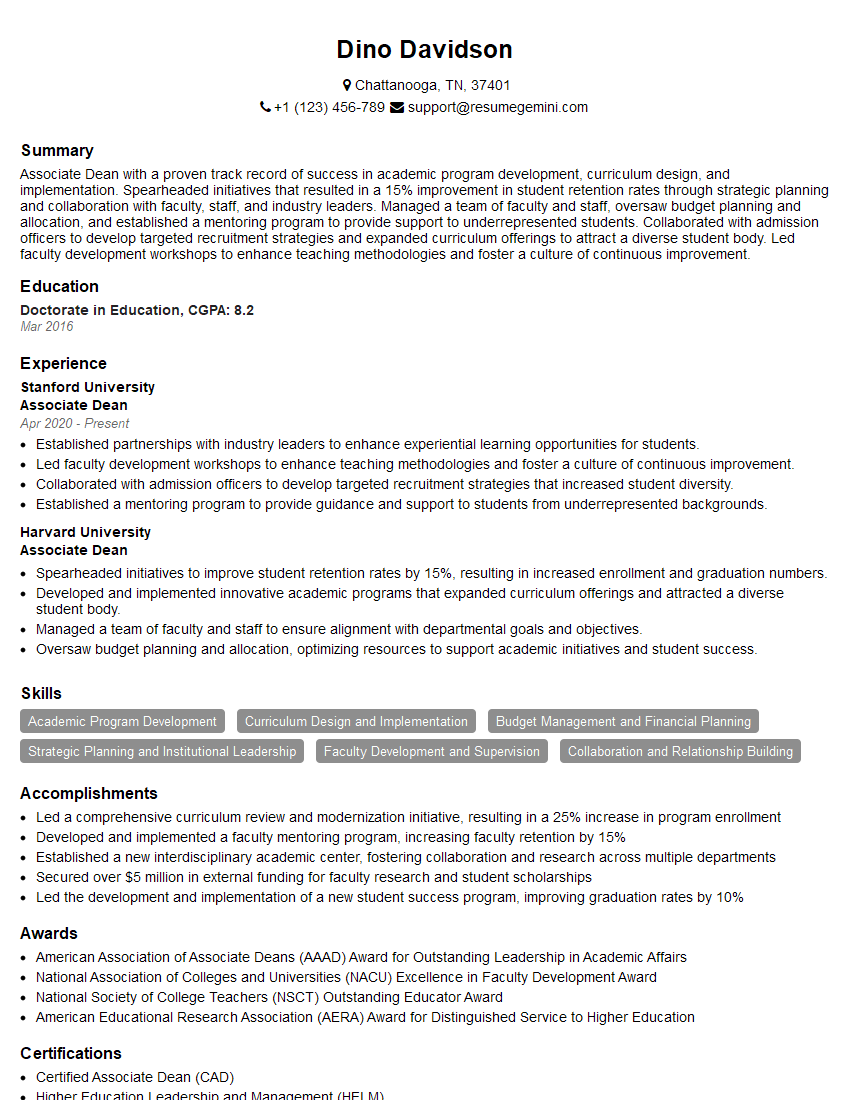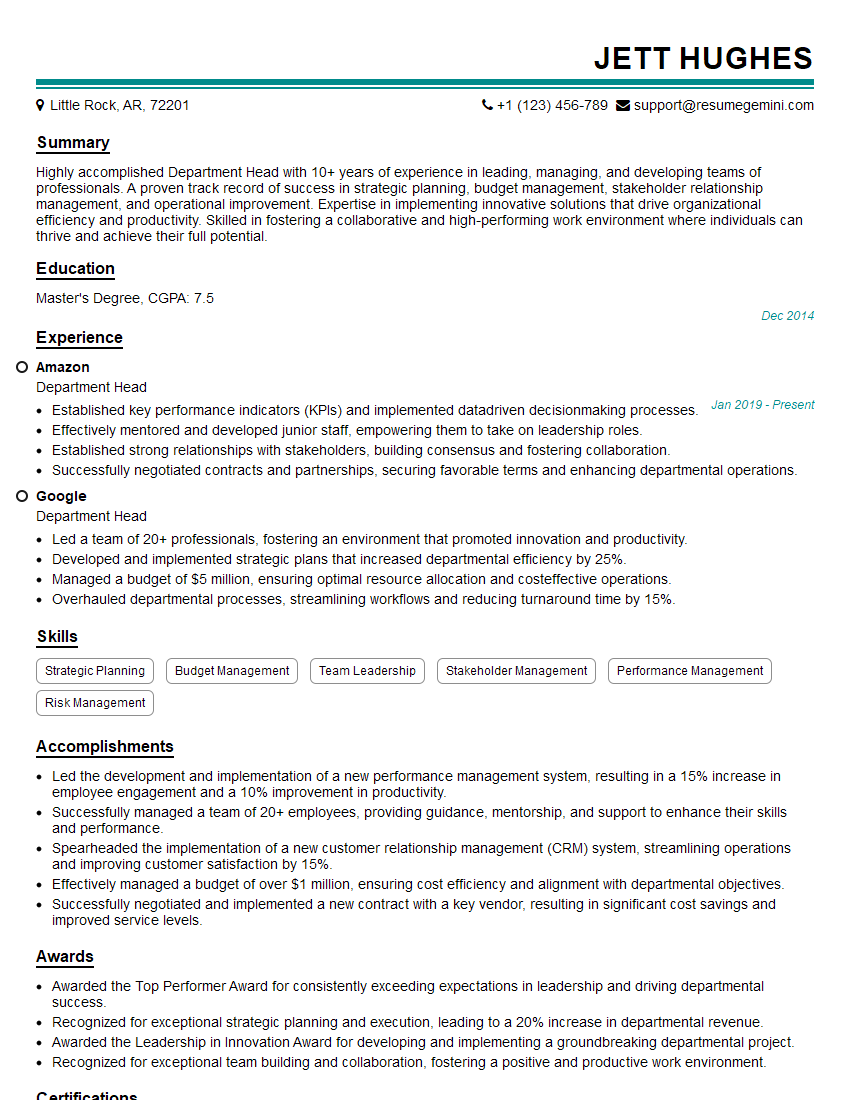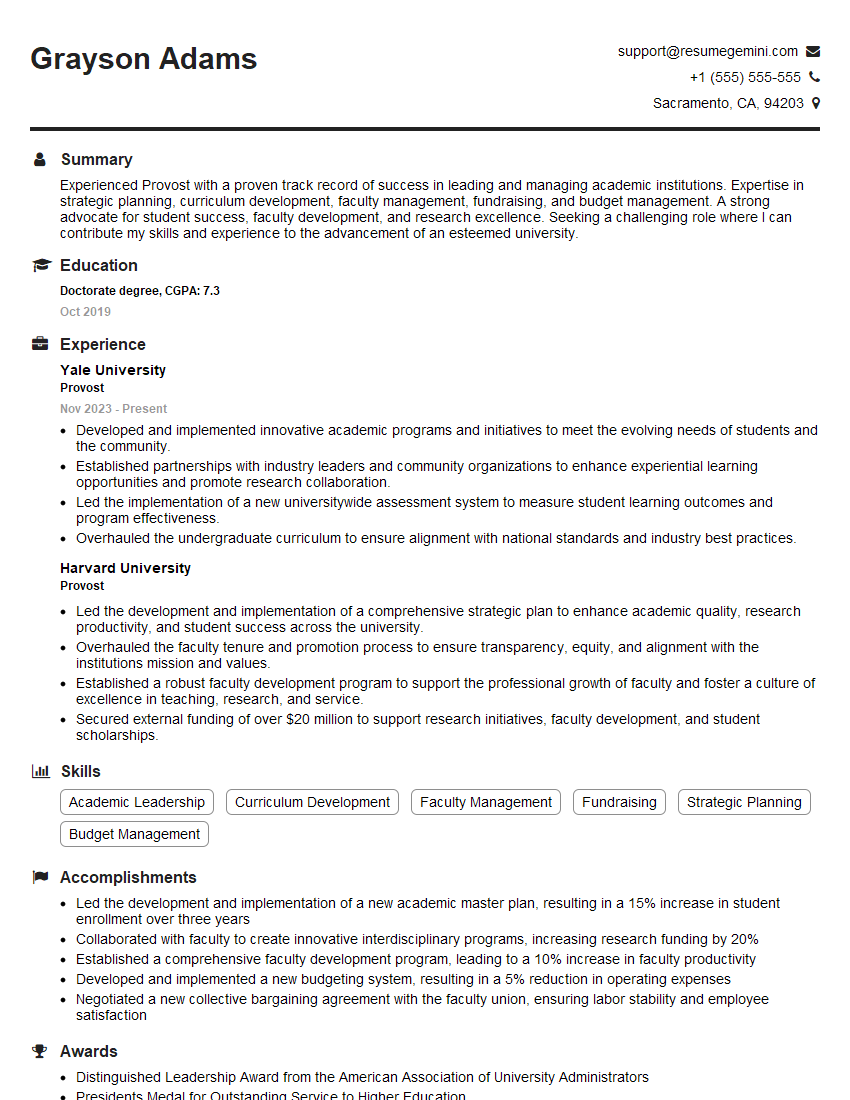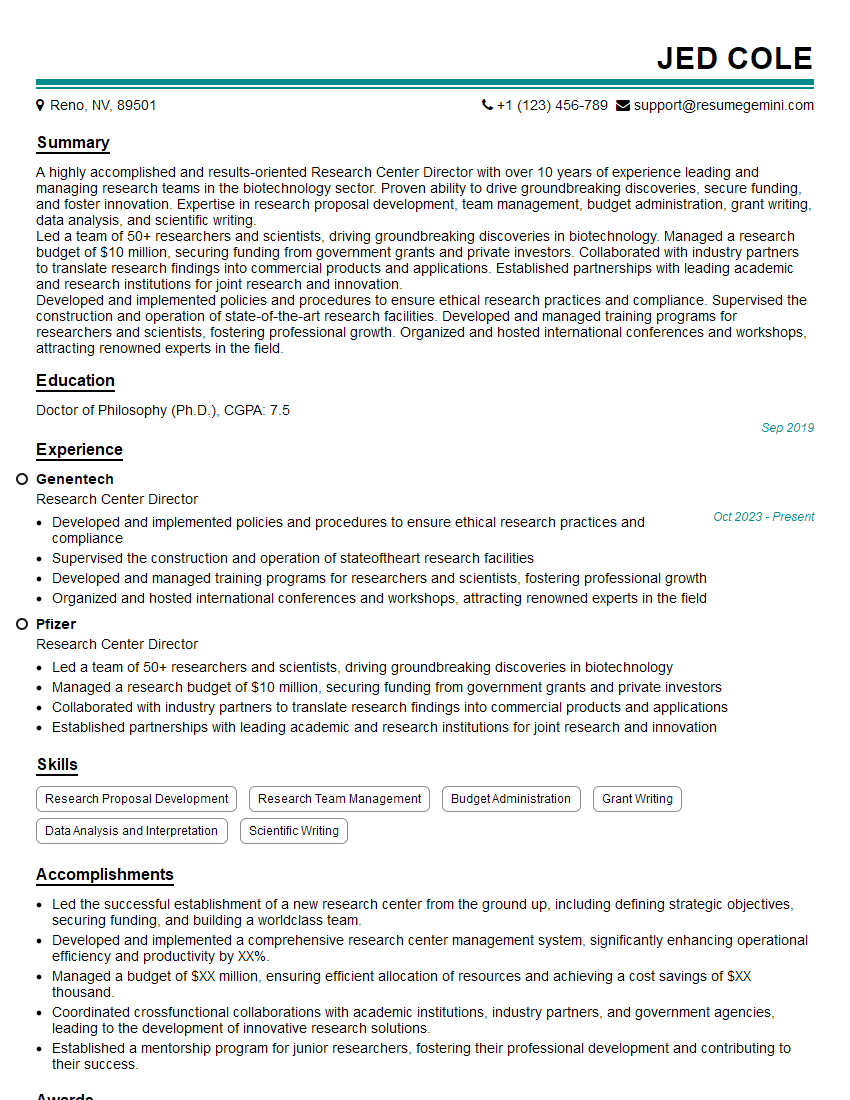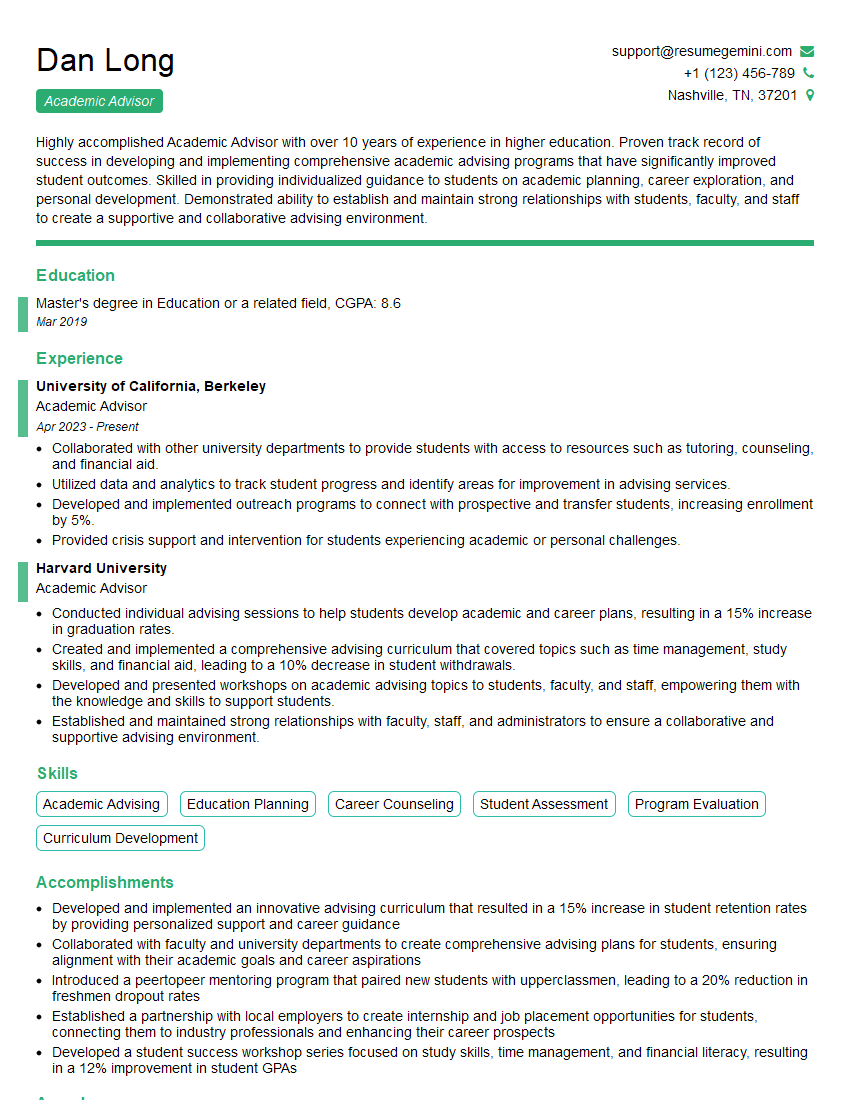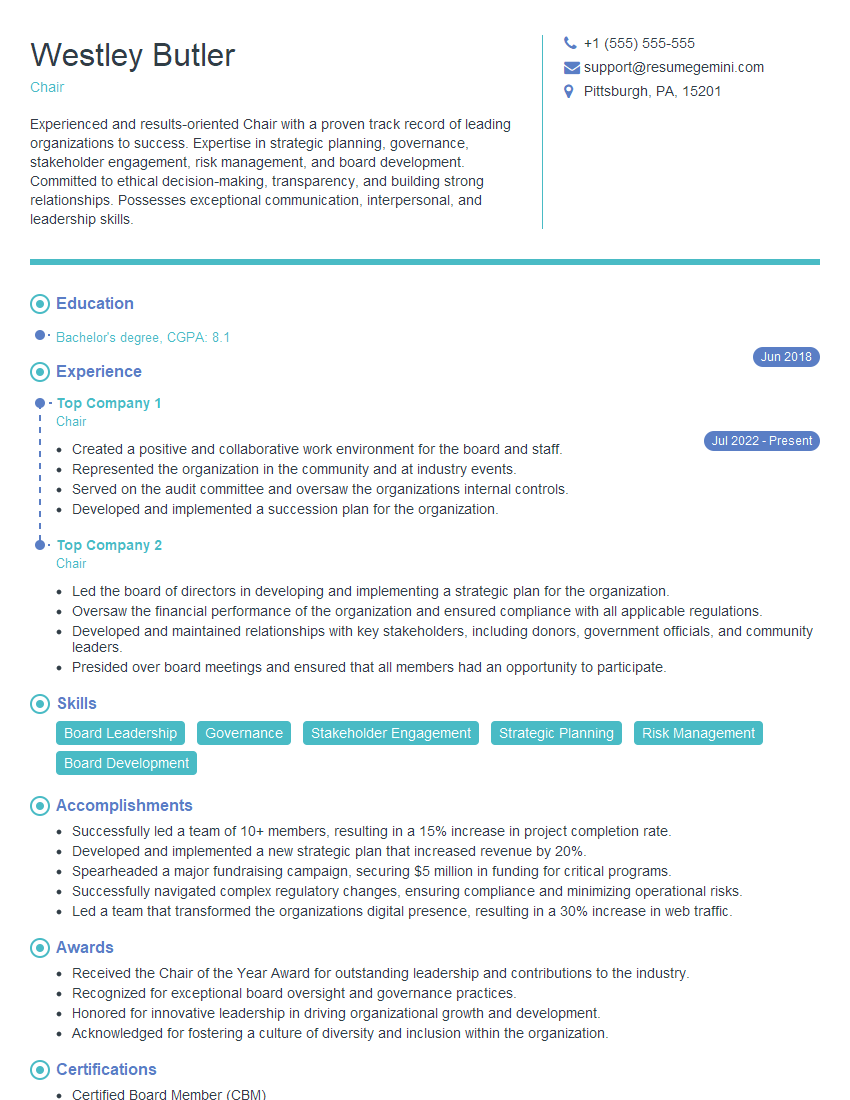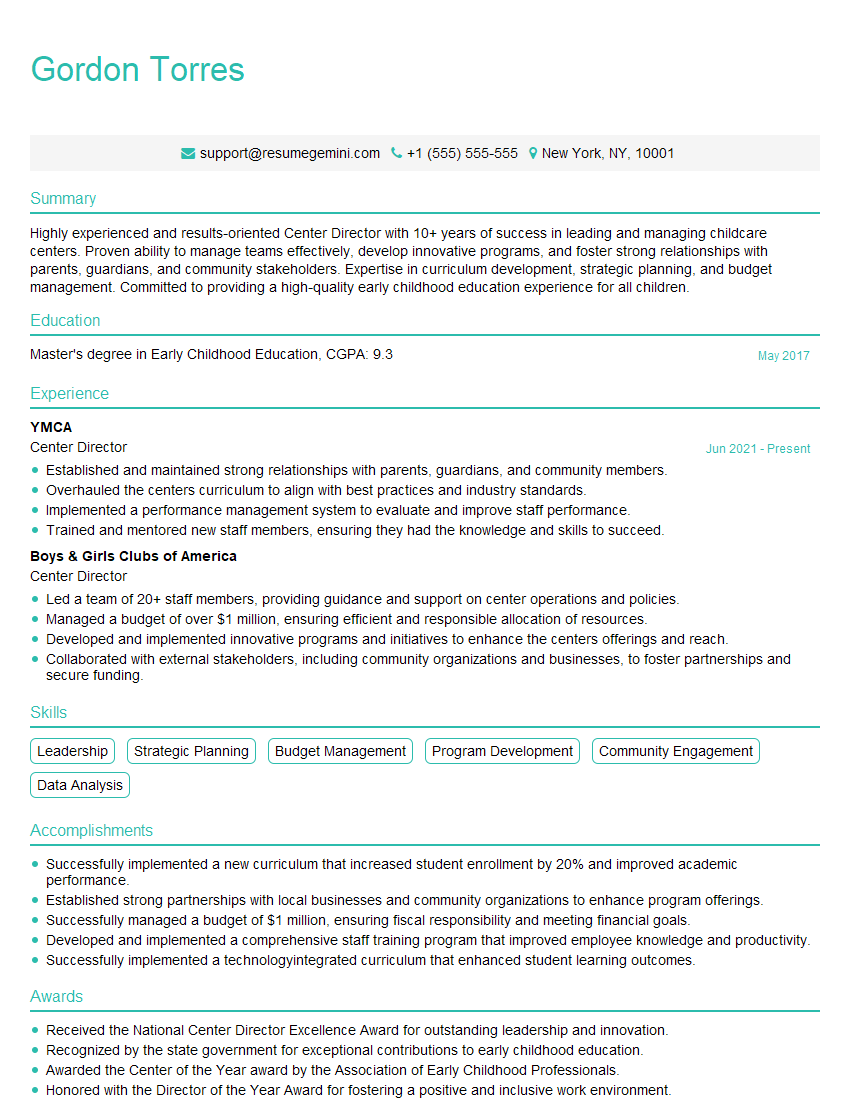Are you ready to stand out in your next interview? Understanding and preparing for Academic Leadership and Service interview questions is a game-changer. In this blog, we’ve compiled key questions and expert advice to help you showcase your skills with confidence and precision. Let’s get started on your journey to acing the interview.
Questions Asked in Academic Leadership and Service Interview
Q 1. Describe your experience managing departmental budgets.
Managing departmental budgets requires a blend of strategic thinking, meticulous tracking, and effective communication. My experience includes overseeing budgets ranging from $500,000 to $2 million annually. This involved not only tracking expenditures against allocated funds but also proactively identifying potential budget shortfalls and developing strategies to mitigate them.
- Forecasting and Planning: I utilize data-driven forecasting methods to anticipate future needs, factoring in inflation, enrollment changes, and potential grant opportunities. For instance, anticipating a drop in enrollment in a specific program allowed us to reallocate funds to support other growing areas.
- Resource Allocation: I prioritize resource allocation based on strategic departmental goals and program needs. This includes carefully considering the allocation of funds for personnel, equipment, supplies, and professional development.
- Transparency and Accountability: I believe in transparent budget management, ensuring that all faculty and staff have access to relevant budget information. Regular budget meetings and reports promote accountability and facilitate collaborative decision-making. For example, I instituted a monthly budget review process, open to all faculty, which fostered a sense of shared responsibility in managing resources.
- Containment and Contingency: I actively seek ways to contain costs while maintaining program quality. This includes exploring alternative vendors, negotiating contracts, and implementing cost-saving measures. We also maintain a contingency fund to address unexpected expenses or emergencies.
Q 2. How have you successfully implemented new curriculum initiatives?
Implementing new curriculum initiatives requires careful planning, collaboration, and a commitment to continuous improvement. My approach involves a multi-stage process, focusing on needs assessment, development, implementation, and evaluation.
- Needs Assessment: This crucial first step involves identifying gaps in the existing curriculum and aligning the new initiatives with the institution’s overall strategic goals and student needs. We used surveys, focus groups, and market research to understand industry demands and student career aspirations.
- Curriculum Development: This phase involves collaborating with faculty experts to design engaging and relevant learning experiences. This included designing new courses, revising existing ones, and integrating technology to enhance learning. For example, we collaborated with industry partners to develop a new data analytics curriculum that included internships and real-world projects.
- Implementation: A phased rollout allows for gradual implementation and addresses potential challenges proactively. This involved training faculty on new pedagogical approaches and providing necessary resources, like new software or lab equipment.
- Evaluation: Continuous evaluation is key to ensuring the effectiveness of the new initiatives. We employed methods such as student feedback surveys, assessment of learning outcomes, and analysis of graduate employment data to measure the impact of the new curriculum. Based on the feedback we made adjustments to improve the curriculum’s effectiveness.
Q 3. Explain your approach to faculty mentoring and development.
Faculty mentoring and development are crucial for institutional success. My approach is based on building strong relationships, providing individualized support, and fostering a culture of continuous learning.
- Individualized Support: I believe in understanding each faculty member’s unique needs and aspirations. This includes regular one-on-one meetings to discuss career goals, research interests, teaching challenges, and professional development opportunities. For example, I helped one junior faculty member secure a major research grant by providing guidance on grant writing and connecting them with potential collaborators.
- Professional Development Opportunities: I actively seek out and facilitate professional development opportunities for faculty, such as workshops, conferences, and sabbatical leaves. We also established an internal mentoring program that pairs senior faculty with junior faculty. This fosters a collaborative learning environment.
- Mentorship Programs: I’ve designed and implemented mentorship programs to connect junior faculty with experienced mentors for guidance on teaching, research, and navigating the academic environment. This provided a structured support system.
- Open Communication and Feedback: Open and constructive feedback is critical for faculty growth. I foster a culture of open communication and regular feedback sessions to help faculty identify areas for improvement and celebrate their successes.
Q 4. Detail your experience with strategic planning in an academic setting.
Strategic planning in an academic setting involves a collaborative process of defining goals, identifying resources, and developing action plans. My experience includes participating in and leading strategic planning initiatives at both departmental and institutional levels.
- Environmental Scan: Beginning with a thorough environmental scan, including market analysis of student demand, competitor analysis, and assessment of internal strengths and weaknesses.
- Goal Setting: Defining clear, measurable, achievable, relevant, and time-bound (SMART) goals aligned with the institution’s mission and vision. This involved engaging faculty and staff in the process.
- Resource Allocation: Identifying and allocating resources strategically to support the achievement of the goals. This included personnel, budget, technology, and facilities.
- Action Planning: Developing detailed action plans with timelines, responsibilities, and metrics for tracking progress. This also includes regular progress reviews and adjustments as needed.
- Implementation and Evaluation: Implementing the action plans and regularly evaluating progress towards the goals. This involved collecting data and making adjustments to ensure the plan remains on track and effective.
Q 5. How do you handle conflict resolution among faculty members?
Conflict resolution among faculty requires a fair, impartial, and timely approach. My strategy focuses on active listening, mediation, and fostering a respectful work environment.
- Active Listening: Understanding each party’s perspective is crucial. I facilitate open communication and encourage each individual to express their concerns without interruption.
- Mediation: I act as a neutral mediator, guiding the parties towards a mutually acceptable solution. This involves identifying common ground and helping them find ways to compromise. For example, in a dispute over office space allocation, I facilitated a discussion that led to a compromise which satisfied both parties.
- Formal Processes: If mediation fails, I follow established institutional procedures for conflict resolution, including documenting the conflict, investigating the issue, and imposing appropriate sanctions where necessary.
- Prevention: A proactive approach to conflict prevention is also important. This involves fostering a respectful and collaborative work environment through team-building activities, clear communication policies, and respectful conflict management training.
Q 6. What is your experience with accreditation processes and compliance?
Accreditation processes and compliance are essential for maintaining the quality and integrity of academic programs. My experience includes leading accreditation efforts for several programs.
- Self-Study: Leading and participating in the self-study process, which involves a comprehensive review of all aspects of the program, including curriculum, faculty qualifications, resources, and student outcomes. We used a collaborative approach to gather data, review policies and procedures, and identify areas for improvement.
- Documentation: Ensuring that all required documentation is accurate, complete, and readily available for review by the accrediting agency. We implemented a robust documentation system, including electronic files and a central repository.
- Compliance: Maintaining ongoing compliance with accreditation standards and regulations. This involved regular monitoring and updates of policies and procedures.
- Site Visit: Preparing for and managing the site visit by the accrediting agency, including coordinating logistics, responding to questions, and addressing concerns raised by the reviewers.
Q 7. Describe your experience in fundraising and grant writing for academic programs.
Fundraising and grant writing are essential skills for securing resources to support academic programs. My experience includes writing successful grant proposals and developing fundraising strategies.
- Grant Writing: I have successfully written and submitted numerous grant proposals to various funding agencies, including government agencies, foundations, and corporations. My success rate in securing funding has been consistently high.
- Fundraising Strategies: I have developed and implemented various fundraising strategies, including cultivating relationships with donors, organizing fundraising events, and creating compelling proposals. For instance, I developed a successful crowdfunding campaign to raise funds for a new student scholarship program.
- Donor Relations: Building and maintaining strong relationships with donors is vital for long-term fundraising success. This involves regular communication, updates on program progress, and expressing gratitude for their support. We established a donor recognition program to acknowledge our supporters.
- Budget Justification: Clearly articulating how funds will be used to support specific program initiatives and achieve measurable outcomes. A strong budget justification strengthens a grant application.
Q 8. How do you assess the effectiveness of academic programs?
Assessing the effectiveness of academic programs requires a multifaceted approach, going beyond simple metrics like graduation rates. It involves a rigorous evaluation of learning outcomes, student satisfaction, program relevance, and resource allocation.
- Learning Outcomes Assessment: We use a variety of methods including surveys, standardized tests, capstone projects, and portfolio reviews to measure how well students achieve the program’s stated learning objectives. For example, in a nursing program, we might assess clinical competency through simulations and real-world patient interactions, alongside written examinations.
- Student Satisfaction Surveys: Regular feedback from students is crucial. We utilize anonymous surveys to gauge their perception of teaching quality, course content, support services, and overall program experience. This data informs curriculum revisions and improvements to student support services.
- Program Relevance and Industry Feedback: We actively engage with industry professionals through advisory boards and internships to ensure the curriculum remains current and meets the needs of employers. This ensures graduates are well-prepared for the workforce.
- Resource Allocation Analysis: Effective programs require efficient resource management. We analyze budgets, faculty workload, and available facilities to identify areas for improvement and ensure resources are aligned with program goals.
By combining these approaches, we create a holistic picture of program effectiveness, enabling data-driven improvements and continuous enhancement.
Q 9. How do you foster collaboration between departments and disciplines?
Fostering interdisciplinary collaboration is essential for creating innovative and impactful research and educational experiences. My approach focuses on creating opportunities for interaction, establishing shared goals, and providing resources that support collaborative efforts.
- Joint Research Initiatives: I encourage the development of joint research grants and projects that involve faculty from different departments. For example, we might bring together engineers, biologists, and computer scientists to address a shared problem, such as developing sustainable energy solutions.
- Interdisciplinary Courses and Programs: Developing courses or entire degree programs that integrate knowledge from multiple disciplines encourages students to think critically and creatively across subject boundaries. A prime example is a collaborative program focusing on environmental studies which brings together expertise in biology, chemistry, social sciences, and policy studies.
- Shared Resources and Facilities: Providing access to shared facilities and technologies fosters collaboration by creating a sense of shared purpose and reliance on one another. For instance, a shared research lab encourages interaction among researchers from different departments with overlapping research interests.
- Faculty Development Workshops: Workshops focused on collaborative research methods, grant writing, and effective communication can equip faculty members with the necessary skills to successfully collaborate across disciplines.
By establishing a culture of collaboration and providing supportive structures, we can facilitate meaningful partnerships across departments and disciplines.
Q 10. Explain your experience with student recruitment and retention strategies.
Student recruitment and retention are critical to the success of any institution. My experience encompasses a range of strategies focusing on attracting high-quality students and providing a supportive environment to ensure their success and continued enrollment.
- Targeted Recruitment Campaigns: We develop targeted recruitment campaigns focused on specific demographic groups and academic interests, utilizing digital marketing, social media, and partnerships with high schools and community colleges. For instance, we’ve developed specific outreach programs focused on attracting underrepresented minorities in STEM fields.
- Enhanced Student Support Services: We provide comprehensive academic advising, tutoring, mentoring, and career counseling to support students throughout their academic journey. This includes early intervention programs to identify and address potential academic challenges.
- Strong Alumni Network: Engaging alumni in the recruitment process can be powerful. We leverage their experiences and network to connect with prospective students and showcase the value of our institution. Alumni talks and events are instrumental in this.
- Data-Driven Decision Making: We use data analytics to track student enrollment trends, identify at-risk students, and evaluate the effectiveness of recruitment and retention strategies. This informs continuous improvement and adjustments to our programs.
A holistic approach that combines targeted recruitment, robust student support, and data-driven decision-making is key to ensuring a healthy and thriving student population.
Q 11. Describe your experience with developing and implementing assessment plans.
Developing and implementing assessment plans involves a systematic process that ensures alignment with program goals, utilizes appropriate assessment methods, and facilitates data-driven improvements.
- Needs Assessment: We begin with a thorough needs assessment to identify the knowledge, skills, and attitudes students should possess upon completion of a program. This is critical for aligning assessment with program goals.
- Assessment Method Selection: We select a range of assessment methods appropriate for different learning outcomes, such as written exams, projects, presentations, and portfolios. The method chosen depends on what aspect of learning we’re aiming to assess.
- Data Collection and Analysis: Once data is collected, a thorough analysis is performed. This includes identifying trends, strengths, and weaknesses in student learning. Statistical analysis often plays a crucial role here.
- Action Planning and Improvement: The analysis informs the development of an action plan to improve teaching, curriculum, and student support based on the findings. This process is iterative, and assessments are regularly reviewed and updated.
A well-designed assessment plan is not merely a compliance exercise; it is a powerful tool for continuous improvement, ensuring programs remain relevant and effective.
Q 12. How have you leveraged technology to enhance teaching and learning?
Technology has dramatically reshaped teaching and learning, and I’ve been at the forefront of integrating innovative tools to enhance the educational experience.
- Learning Management Systems (LMS): We utilize LMS platforms such as Canvas or Blackboard to facilitate online course delivery, manage assignments, and provide students with access to learning resources. This enhances accessibility and flexibility.
- Interactive Simulations and Virtual Labs: In fields like science and engineering, interactive simulations and virtual labs provide students with hands-on experiences that may not be feasible in a traditional setting, reducing costs and enhancing safety.
- Collaborative Learning Tools: Tools like Google Docs or collaborative online platforms foster real-time interaction and collaborative learning among students, regardless of their location.
- Data Analytics for Personalized Learning: We leverage data analytics from LMS and other learning tools to understand individual student learning styles and progress, allowing for personalized instruction and targeted interventions.
Careful selection and integration of technology, alongside professional development for faculty, are essential to ensuring effective and engaging use of technological tools in education.
Q 13. Explain your experience in managing diverse teams of faculty and staff.
Managing diverse teams requires strong leadership, communication, and a commitment to creating an inclusive and equitable environment. My approach centers on building trust, fostering open communication, and valuing diverse perspectives.
- Open Communication and Feedback Mechanisms: I establish regular channels for communication and feedback, including team meetings, one-on-one meetings, and anonymous surveys to ensure everyone feels heard and valued.
- Conflict Resolution Strategies: I equip myself with effective conflict resolution strategies to address disagreements fairly and constructively, promoting a collaborative atmosphere.
- Mentorship and Professional Development: I invest in mentoring and professional development opportunities for team members, supporting their growth and career advancement. This builds loyalty and competence.
- Inclusive Decision-Making: I foster an inclusive decision-making process that values diverse perspectives and ensures everyone’s voice is considered. This leads to better, more creative solutions.
By creating a supportive and equitable environment, I can leverage the diverse strengths of my team to achieve shared goals and create a thriving workplace.
Q 14. Describe your approach to building and maintaining strong relationships with external stakeholders.
Building and maintaining strong relationships with external stakeholders, including alumni, industry partners, government agencies, and community organizations, is crucial for the success of any academic institution. My approach prioritizes open communication, mutual benefit, and long-term engagement.
- Regular Communication and Networking: I maintain regular communication with stakeholders through newsletters, events, meetings, and personal outreach. Networking is paramount to building rapport and understanding mutual needs.
- Strategic Partnerships: I actively seek out and develop strategic partnerships that align with the institution’s mission and goals, creating mutually beneficial collaborations. This might involve joint research projects, internships, or funding opportunities.
- Community Engagement: I emphasize community engagement through outreach programs, workshops, and volunteer opportunities that benefit both the community and the institution. This builds goodwill and a strong reputation.
- Feedback Mechanisms: I establish clear feedback mechanisms to ensure stakeholders feel heard and their input is valued. This facilitates continuous improvement and strengthens relationships.
By focusing on mutual benefit, open communication, and consistent engagement, I build and maintain strong, productive relationships with external stakeholders that benefit the institution and the wider community.
Q 15. How do you prioritize competing demands and manage your time effectively?
Prioritizing competing demands in academic leadership requires a structured approach. I utilize a combination of time-blocking, prioritization matrices, and delegation. Think of it like conducting an orchestra – each instrument (task) has its own importance and timing.
My time-blocking strategy involves scheduling specific time slots for crucial tasks, such as strategic planning, faculty meetings, and research collaborations. I use a prioritization matrix (like the Eisenhower Matrix – Urgent/Important) to categorize tasks, focusing first on high-impact, urgent items. This ensures that critical initiatives receive the attention they deserve. For less urgent but important tasks, I schedule them proactively.
Finally, I believe strongly in effective delegation. I identify tasks that can be successfully handled by others on my team, empowering them and freeing up my time for higher-level strategic decision-making. For example, during a particularly busy period involving a major accreditation review, I delegated the preparation of certain supporting documents to trusted members of my staff, allowing me to focus on the overall strategy and communication with the accreditation body. This collaborative approach is crucial for effective time management.
Career Expert Tips:
- Ace those interviews! Prepare effectively by reviewing the Top 50 Most Common Interview Questions on ResumeGemini.
- Navigate your job search with confidence! Explore a wide range of Career Tips on ResumeGemini. Learn about common challenges and recommendations to overcome them.
- Craft the perfect resume! Master the Art of Resume Writing with ResumeGemini’s guide. Showcase your unique qualifications and achievements effectively.
- Don’t miss out on holiday savings! Build your dream resume with ResumeGemini’s ATS optimized templates.
Q 16. What is your experience with developing and implementing diversity and inclusion initiatives?
Developing and implementing diversity and inclusion initiatives is a core aspect of effective academic leadership. My experience involves a multi-pronged approach, focusing on recruitment, retention, and curriculum.
In recruitment, I’ve actively sought diverse candidate pools, using targeted advertising and partnering with organizations focused on underrepresented groups. We’ve also implemented blind resume screening to mitigate unconscious bias. For retention, we’ve established mentorship programs pairing senior faculty with junior faculty from diverse backgrounds, and created employee resource groups to foster a sense of belonging.
In curriculum, we’ve integrated diversity and inclusion training into faculty professional development programs and revised curricula to include diverse perspectives and voices. For instance, I spearheaded an initiative to diversify our course offerings by inviting guest lecturers from different ethnic backgrounds and professional experiences, thus enriching students’ learning and promoting a more inclusive learning environment. Assessing the success of these initiatives involves tracking key metrics such as faculty and staff demographics, student satisfaction surveys, and participation rates in diversity-related programs.
Q 17. How do you evaluate the performance of faculty and staff?
Evaluating faculty and staff performance involves a balanced approach using multiple data points and a focus on continuous improvement. A 360-degree review process, combining self-assessment, peer evaluation, student feedback, and supervisor assessment, provides a holistic view of individual performance.
For faculty, teaching effectiveness is assessed through student evaluations, course observations, and examination of teaching materials. Research productivity is measured through publications, grants secured, and presentations at conferences. For staff, performance is evaluated based on job descriptions, key performance indicators (KPIs), and project outcomes. Regular check-ins and feedback sessions are crucial for fostering a culture of continuous learning and improvement. Performance evaluations shouldn’t be solely about judgment; they should serve as opportunities for growth and development, building stronger teams.
Q 18. Describe your experience with crisis management in an academic setting.
Crisis management in academia requires a swift, decisive, and transparent approach. My experience includes handling situations such as student emergencies, faculty misconduct allegations, and unforeseen budget cuts.
My approach involves a four-step process: 1) Assessment: Quickly gather information to understand the scope and impact of the crisis. 2) Response: Initiate immediate actions to mitigate the immediate consequences and ensure safety. 3) Communication: Establish clear and consistent communication channels to keep all stakeholders informed. 4) Recovery: Develop and implement a plan to address the long-term implications of the crisis and prevent recurrence. For example, during a campus-wide power outage, I led a coordinated effort to ensure student safety, provide alternative learning spaces, and communicate effectively with students, faculty, and staff. Effective communication and a coordinated response were critical to mitigating the disruption.
Q 19. How do you ensure the quality of teaching and research within your department?
Ensuring quality in teaching and research requires a proactive and multi-faceted strategy. For teaching, we focus on faculty development, curriculum review, and student feedback mechanisms.
We provide regular professional development opportunities, such as workshops on pedagogical best practices and technology integration. We also conduct periodic reviews of our curricula to ensure alignment with disciplinary standards and student needs. Student feedback, collected through surveys and course evaluations, provides valuable insights for continuous improvement. For research, we prioritize the provision of adequate resources, mentorship programs for junior faculty, and encouragement of collaborative research projects. We also emphasize the importance of ethical conduct and rigor in research methodologies. Regular review of research output and impact assessments are key to measuring the overall quality of our research endeavors.
Q 20. Explain your experience with navigating institutional policies and procedures.
Navigating institutional policies and procedures effectively is essential for academic leaders. My experience involves a deep understanding of the rules, regulations, and processes governing the institution.
This understanding allows me to ensure compliance, make informed decisions, and advocate effectively for my department’s needs. I approach this by thoroughly reviewing relevant documentation, consulting with legal counsel when necessary, and staying abreast of changes in policies and regulations. For example, when dealing with faculty tenure and promotion processes, I meticulously follow established procedures to ensure fairness and transparency. A robust understanding of institutional policies is crucial not only for compliance but also for effective strategic decision-making and resource allocation.
Q 21. How do you promote a positive and productive work environment?
Promoting a positive and productive work environment requires a collaborative and supportive approach. This involves fostering open communication, valuing diversity, and providing opportunities for professional development.
Open communication is crucial – I encourage regular team meetings, feedback sessions, and informal interactions to create a culture of transparency and trust. I believe in recognizing and rewarding contributions to boost morale. Opportunities for professional development, such as attending conferences or pursuing advanced training, are also critical for employee growth and job satisfaction. Creating a space where individuals feel valued, respected, and supported allows them to thrive both personally and professionally. In one instance, we organized team-building activities to strengthen relationships and improve communication. These measures have contributed significantly to building a positive and high-performing work environment.
Q 22. Describe your approach to data-driven decision-making in academic administration.
My approach to data-driven decision-making in academic administration centers on using quantitative and qualitative data to inform strategic planning and resource allocation. It’s not just about crunching numbers; it’s about understanding the story the data tells.
For instance, I wouldn’t simply look at overall graduation rates. I’d delve into the data to identify subgroups of students – by major, ethnicity, socioeconomic background, etc. – to understand where disparities might exist. This allows for targeted interventions.
I use data visualization tools to present findings clearly and concisely to stakeholders. This helps everyone understand the implications and collaboratively develop solutions. For example, if retention data shows a high attrition rate among first-year students in a specific major, we might create a targeted mentorship program or revise the introductory curriculum based on student feedback gathered through surveys and focus groups. Finally, I believe in continuous monitoring and evaluation. We regularly track the impact of our decisions to ensure they’re achieving their intended outcomes and make adjustments as needed.
Q 23. What is your experience with developing and implementing innovative teaching methods?
Developing and implementing innovative teaching methods is a passion of mine. My experience includes championing active learning strategies like flipped classrooms, peer instruction, and problem-based learning.
In one instance, I spearheaded the integration of project-based learning into a previously lecture-heavy curriculum. Students were tasked with tackling real-world problems relevant to their field, fostering critical thinking and collaborative skills. The results showed a significant improvement in student engagement and performance, as evidenced by higher grades and increased student satisfaction in course evaluations.
I also advocate for incorporating technology effectively in teaching. This might involve utilizing learning management systems (LMS) for interactive learning modules, online discussions, or incorporating digital tools for collaborative projects.
Q 24. How do you advocate for the needs of your department or college?
Advocating for my department or college involves building strong relationships with stakeholders at all levels – from faculty and staff to deans, provosts, and university leadership.
This requires strategic communication, articulating the department’s needs and accomplishments clearly and persuasively. I prepare compelling proposals that demonstrate the impact of our work and justify the allocation of resources. For example, when advocating for new equipment for a laboratory, I wouldn’t simply request funding; I would present data demonstrating the projected increase in student enrollment and research output resulting from the upgrade. I also actively seek out opportunities for collaboration, building partnerships with other departments and external organizations to leverage resources and expand our impact.
Q 25. Describe your experience with student affairs and their integration with academics.
My experience with student affairs highlights the crucial link between academic success and holistic student well-being. I believe that a strong integration of academics and student affairs is essential for student success.
I’ve been involved in initiatives that connect academic advisors with student support services, ensuring students receive timely interventions when facing academic or personal challenges. For example, early warning systems, which flag students at risk of academic difficulty, can be effectively coupled with referrals to counseling or tutoring services. Successful integration often involves collaborative efforts, ensuring that all support systems work together to create a supportive and inclusive environment.
Q 26. How do you balance the needs of students, faculty, and administration?
Balancing the needs of students, faculty, and administration requires a nuanced understanding of each group’s priorities and a commitment to finding common ground.
It’s about effective communication and fostering a collaborative environment where everyone feels heard and respected. For example, when faced with budget cuts, I would engage in transparent discussions with faculty about potential solutions, involving them in the decision-making process. This might involve exploring alternative teaching methods or prioritizing certain initiatives based on collective input. Similarly, I would ensure that students are kept informed of any changes that might affect their education, actively seeking their feedback.
Q 27. What are your strategies for improving student success and graduation rates?
Improving student success and graduation rates requires a multi-pronged approach. My strategies include early intervention programs to identify and support at-risk students, enhanced academic advising, and the development of robust support services such as tutoring and mentoring.
I also focus on creating a supportive and inclusive campus climate, addressing factors that might hinder student success, such as financial insecurity or lack of access to resources. For example, I have been instrumental in developing programs connecting students with scholarship opportunities and providing financial literacy workshops. Data analysis plays a crucial role in identifying areas for improvement and measuring the effectiveness of interventions.
Q 28. How do you maintain ethical and transparent practices in academic leadership?
Maintaining ethical and transparent practices in academic leadership is paramount. This involves adhering to institutional policies and procedures, acting with integrity, and fostering a culture of accountability.
Transparency is key: I believe in open communication with all stakeholders, providing regular updates and seeking feedback. Conflict of interest policies are strictly followed, and decisions are made based on objective criteria, rather than personal biases. I also prioritize fair and equitable treatment of all individuals, fostering a diverse and inclusive environment. This includes establishing clear processes for addressing grievances and ensuring due process for all members of the academic community.
Key Topics to Learn for Academic Leadership and Service Interview
- Strategic Vision & Planning: Developing and articulating a compelling vision for academic departments or initiatives. Practical application: Describe a time you successfully influenced strategic direction within an academic setting.
- Team Building & Collaboration: Fostering effective teamwork and collaboration among diverse faculty, staff, and students. Practical application: Share an example of successfully resolving conflict or building consensus within a team.
- Resource Management & Budgeting: Effectively managing resources (financial, human, technological) to achieve academic goals. Practical application: Explain your experience with budget allocation and justification within an academic context.
- Mentorship & Faculty Development: Guiding and supporting the professional growth of colleagues and students. Practical application: Describe your approach to mentoring junior faculty or students.
- Assessment & Evaluation: Developing and implementing effective methods for assessing program effectiveness and student learning outcomes. Practical application: Explain your experience designing and implementing assessment strategies.
- Communication & Advocacy: Effectively communicating academic priorities and advocating for departmental or institutional needs. Practical application: Share an example of successfully advocating for a program or initiative.
- Conflict Resolution & Negotiation: Addressing and resolving conflicts constructively and fairly. Practical application: Describe a situation where you successfully mediated a disagreement.
- Diversity, Equity, and Inclusion (DEI): Promoting inclusive practices and fostering a welcoming environment for all members of the academic community. Practical application: Explain your understanding of and commitment to DEI principles.
- Change Management: Leading and managing organizational change effectively. Practical application: Describe your experience navigating significant changes within an academic setting.
Next Steps
Mastering Academic Leadership and Service is crucial for career advancement in higher education. It demonstrates your ability to contribute significantly to the success of an institution and foster a thriving academic environment. To increase your job prospects, creating an ATS-friendly resume is essential. ResumeGemini is a trusted resource that can help you build a compelling and effective resume that highlights your skills and experience in Academic Leadership and Service. Examples of resumes tailored to this field are available to guide you through the process. Invest time in crafting a strong resume – it’s your first impression and a critical step in securing your desired role.
Explore more articles
Users Rating of Our Blogs
Share Your Experience
We value your feedback! Please rate our content and share your thoughts (optional).
What Readers Say About Our Blog
good
